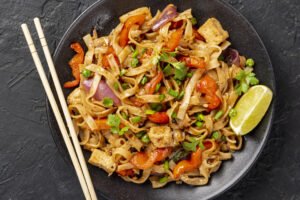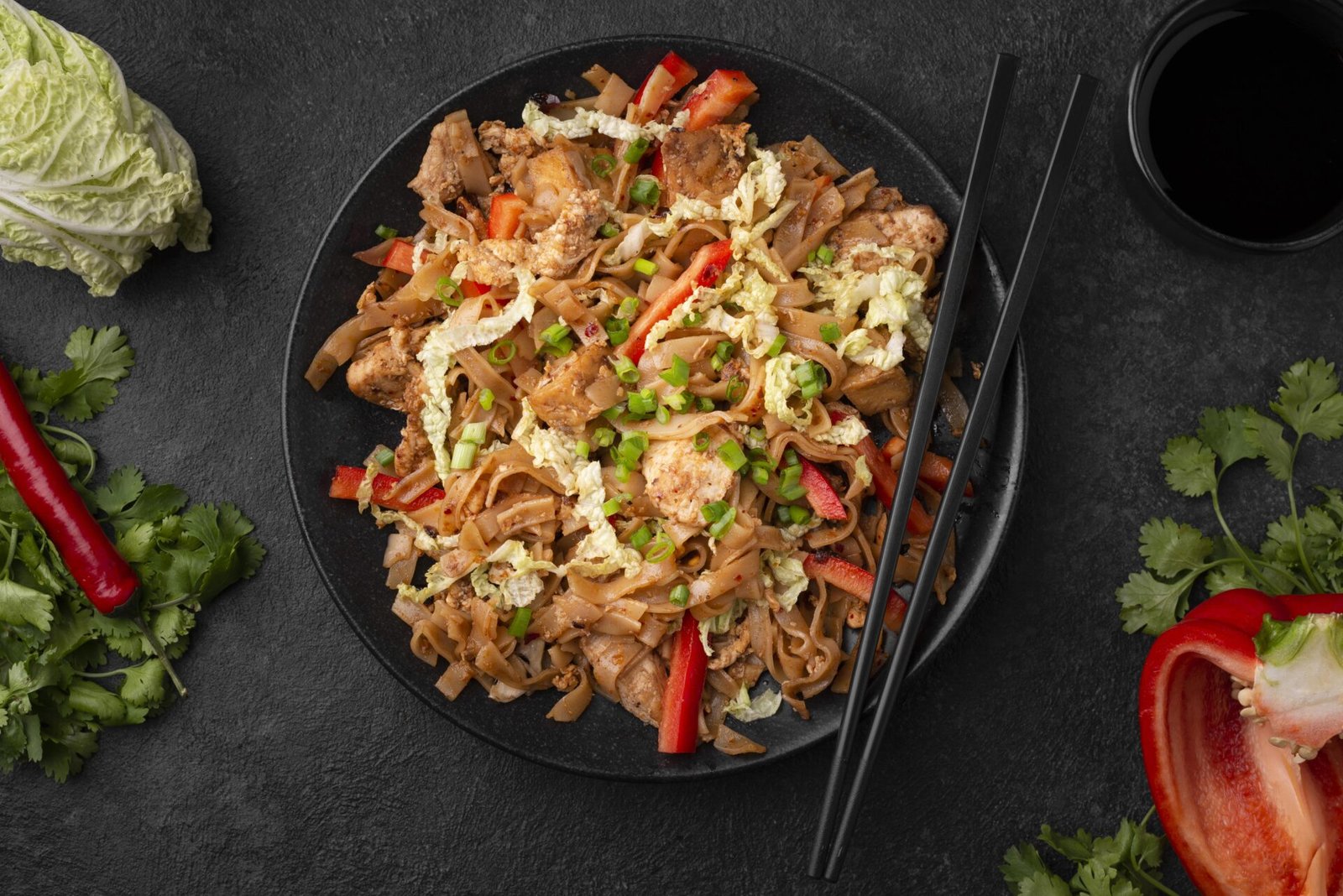Pad Thai

Ingredients:
– 8 oz (about 225g) dried rice noodles
– 2 tablespoons vegetable oil
– 2 cloves garlic, minced
– 8 oz (about 225g) protein of your choice (shrimp, chicken, tofu, or a combination)
– 2 eggs, lightly beaten
– 2 cups bean sprouts
– 4 green onions, thinly sliced
– 1/4 cup chopped peanuts
– Lime wedges, for serving
– Chopped cilantro, for garnish (optional)
For the Pad Thai sauce:
– 3 tablespoons tamarind paste
– 3 tablespoons fish sauce
– 2 tablespoons soy sauce
– 2 tablespoons brown sugar
– 1 tablespoon rice vinegar
– 1 teaspoon chili paste or sriracha (adjust to taste)
Instructions:
1. Prepare the Rice Noodles:
– Submerge the dried rice noodles in a big bowl and pour hot water over the noodles ensuring they are fully submerged. The rice should be allowed to rest in the mixture for approximately thirty minutes, although it should not be overly soft and should still offer some resistance to the pressure. Transfer the noodles to a colander and rinse to drain the water, and put the noodles aside.
2. Make the Pad Thai Sauce:Make the Pad Thai Sauce:
– Tamarind paste, fish sauce, soy sauce, brown sugar, rice vinegar, chili paste (or sriracha) are put in a small bowl and whisked together. It is highly recommended to adjust sweetness or spiciness depending on your taste or your guest if you are preparing the food for others.
3. Prepare the Protein:
– Place the skillet or wok on the cook top on medium-high heat and heat 1 tablespoon of vegetable oil. Mix garlic and cook it for about 1/2 incher until it turns brown.
– Finally, put the protein you prefer (shrimp, chicken, tofu) into the skillet and cook it to the correct texture. However, if using shrimp, it should be cooked until it changes color to a bright pink and translucent. The chicken, tofu, or beef must be fully fried and slightly crispy to be properly integrated into the noodle mixture later. Sear the cooked protein until it is nicely browned on the outside for easy carving then place it aside.
4. Cook the Eggs:
– Pour the beaten eggs and fry, stirring occasionally, until there is a firmly set scrambled egg mixture. Also, the green onion and garlic should be removed from the skillet once cooked.
5. Stir-Fry the Noodles:
– Pour the stuff pad Thai sauce into the skillet and mix it well with the soaked rice noodles. Finally add the noodles and mix everything together with a spoon so the sauce covers the noodles and the noodles are hot.
6. Add the Remaining Ingredients:
– Return the cooked protein to the skillet; let it become hot again then add the bean sprouts and sliced green onions. In a scenario that takes not more than half an hour, all the ingredients should be tossed together to combine and cook until they are hot.
7. Serve:
– This way, transfer the Pad Thai to serving plates or bowls. Bake the chicken until done, and then sprinkle chopped peanuts on the top, lime wedges, and chopped cilantro if desired.
– Serve immediately and enjoy your delicious homemade Pad Thai!
Feel free to customize your Pad Thai by adding additional toppings or ingredients, such as sliced potatoes, carrots, or broccoli, to suit your tastes. Adjust the spiciness by adding more or less chilli paste or sriracha. Have fun experimenting and creating your own perfect Pad Thai dish!
Pad Thai calories:
Pad Thai, while primarily known for its delicious and satisfying texture, can also provide some nutritional benefits, especially when made with fresh, healthy ingredients, Some of the potential benefits of Pad Thai here’s a closer look:
1. Fiber-rich foods: Typically, a variety of fiber-rich foods such as rice noodles, proteins (shrimp, chicken, tofu), vegetables (bean sprouts, green onions), and garnishes (peanuts, lime, cilantro) are it’s in Pad Thai . . . . . These products provide essential nutrients such as carbohydrates, protein, fiber, vitamins (such as vitamin C, vitamin A, and various B vitamins), minerals (such as potassium, magnesium, and calcium), and antioxidants infectious diseases
2. Balanced macronutrients: Pad Thai offers a balanced combination of macronutrients, with carbohydrates from rice noodles, protein from protein sources (shrimp, chicken, tofu), and healthy fats from tea sources including in corn or vegetable oils.
3. Protein Source: By using protein source, Pad Thai can provide more high quality protein. Protein is essential for building and repairing muscles, supporting muscle health, and supporting various metabolic processes.
4. Complex carbohydrates: The rice noodles used in Pad Thai are a source of complex carbohydrates, which provide a steady supply of energy and help maintain blood sugar levels Complex carbohydrates also contains fiber, which supports digestive health and helps to feel fuller and heavier.
5. Vegetable Ingredients: Pad Thai usually consists of vegetables like bean sprouts, green onions, which add vitamins, minerals and fiber to the dish These vegetables help with overall nutrition and provide essential micronutrients supporting bodily functions and promoting overall health6. Flexible Pad Thai Ingredients: Pad Thai can easily be customized to include additional vegetables or protein sources depending on individual preferences and dietary needs. Adding more vegetables can boost the fiber and nutritional value of the dish, while choosing a lean protein can help reduce total fat
7. Low Fat Ingredients: While there is some fat in products like Pad Thai corn or vegetable oil, there is generally not much, especially when homemade with very little oil. Choosing healthy fats and maintaining portion sizes can help keep the fat content in check.
8. Cultural and Culinary Delight: In addition to the nutritional benefits, Pad Thai offers cultural and culinary delight, creating a delicious and satisfying dining experience that can be shared with friends and family. Access to healthy, tasty food contributes to overall well-being and enhances the pleasure of eating.
While Pad Thai can be a delicious and satisfying meal, it’s important to focus on portion size and choice of ingredients, especially if you have specific dietary goals or health considerations. Choosing fresh, high-quality ingredients and making pad thai at home can give you greater control over nutrients and help create a balanced, healthy diet.
